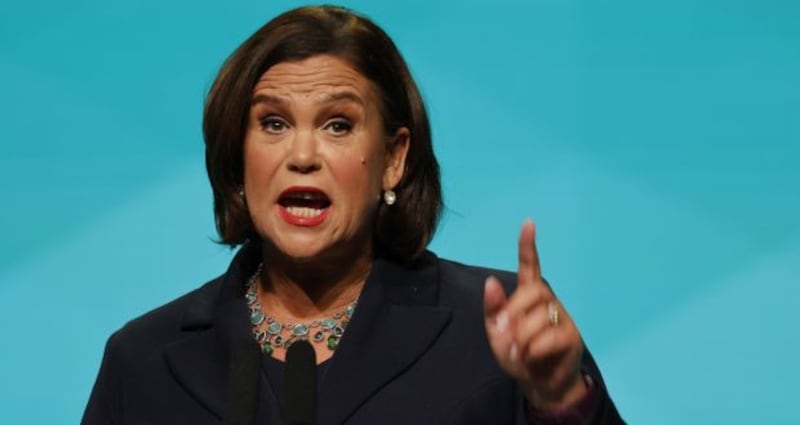There was a row in the Dáil this week as Leo Varadkar threw off the shackles and went bald-headed for Pearse Doherty and Sinn Féin. The exchange tells us a lot about the likely trajectory of politics over the coming months.
Long goaded by Sinn Féin about being an out-of-touch metropolitan elitist on one hand and his yet unresolved business with the criminal justice system over the leaking controversy on the other, Varadkar has been contemplating and preparing his responses for some time now. Attack is the best form of defence, and all that. His escalation in response to the barbs from Doherty — a studs-up tackler himself — was as brutal as it was sudden. It made Doherty look like a man who brought a knife to a gunfight, and sent Fine Gael TDs home on Thursday with a spring in their step for the first time in a long time.
Varadkar had his retaliation ready to go, with the Fine Gael research team having done their work thoroughly. And while one might remark in passing that many of us have had our youthful collars felt for calling a garda a b****cks after a skinful, it’s also true that few of us have tried to claim this was “political policing” — or part of a “vicious wave of garda repression”, as An Phoblacht reported.
Different politics, different time; but hardly a lifetime ago. And if it is correct that Sinn Féin makes the case that it has been central to the transformation of Irish politics north and south, it’s okay too for its opponents to point out that not so long ago it wanted to upend the state it now aspires to govern.
READ MORE
But it was the current political context that gave the row its greater-than-usual volume — I think for three reasons. Firstly, the exchange was about — ostensibly, anyway — the rising cost of living. That is something that every household in the country is experiencing. It isn’t a row over Katherine Zappone’s job, or the leaking of a document, or some other ministerial misdemeanour — it’s something that everyone cares about because everyone feels it directly.
Secondly, Fine Gael and the rest of the Government know that they will be under extreme political pressure on this front for the foreseeable future. The pressure will be heightened by the pungency of Sinn Féin’s populist critique — portraying the Government as out-of-touch elitists ignoring the needs of the ordinary people — which will intensify as the squeeze on incomes and living standards grows. You wouldn’t have to be the world’s greatest political analyst to know this tactic has worked rather well elsewhere.
It’s very difficult to combat effectively. To do so, the Government must undermine the credibility of the Sinn Féin message, and to do that effectively it will seek to undermine the Sinn Féin leadership personally: “Look at Mary Lou, she’s as big an elitist as anyone, with her champagne and first-class flights and €1,000-a-plate dinners.”

Thirdly, Fine Gael has long been trying to frame electoral choices as a binary between itself and Sinn Féin. This failed at the last general election and it failed again at the Dublin Bay South byelection a year ago — not least because Irish voters know they have an array of political options, not just two, and tend to rather relish that.
But just because a strategy failed before doesn’t mean that it cannot succeed in a different context. And the future context will be different for two principal reasons: one, because Sinn Féin will have a very real chance of leading the next government and, two, because Fine Gael is moving to a more targeted political communications strategy, concentrating on the 25 or 30 per cent of people who might consider voting for it (and might be fearful of a Sinn Féin government) rather than a wider group. As noted hereabouts before, the party leadership no longer wants to be all things to all people.
None of this means that the strategy of defining politics as Fine Gael versus Sinn Féin in order to herd anti-Sinn Féin voters into the Fine Gael enclosure is going to work. I have my doubts. But I am pretty sure that’s what Fine Gael is going to try.
Supporting evidence arrives in the shape of a recent Fine Gael wave of private research, about which the friendly owner of a blue shirt has been good enough to share some details. Among a variety of other topics (including neutrality, interestingly) it asked participants’ reaction to different statements about Sinn Féin.
[ Miriam Lord: Venomous Varadkar finds Sinn Féin’s poor mouth a bit richOpens in new window ]
Among them were: “Sinn Féin wants handouts all over the place but don’t ever say how they would pay for them”; “Sinn Féin has a lack of integrity/Different policies north and south”; “I am worried about the impact of Sinn Féin in government on business and employers”; “the middle class would end up paying for their populist promises”; “Sinn Féin support for the IRA’s campaign of violence makes them unsuitable”; “Sinn Féin is not a normal party”; “I am concerned about reports of attitudes towards women, and allegations of bullying within Sinn Féin”; “Sinn Féin would wreck the economy”; “I am worried about the impact of Sinn Féin in government on our international reputation and our place in Europe”; and so on.
These are the messages about Sinn Féin that you’ll be hearing from Fine Gael.
Just as interesting, though, was another question: “To what extent would you be more likely or less likely to give your first preference vote to Fianna Fáil, if they were to suggest they would be prepared to go into government with Sinn Féin under the right circumstances?”
Varadkar may be targeting Sinn Féin for a political assault – but it’s Fianna Fáil’s voters he’s after.













